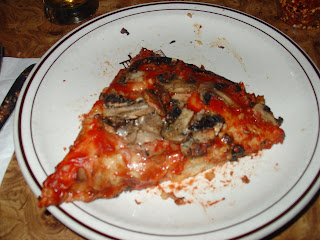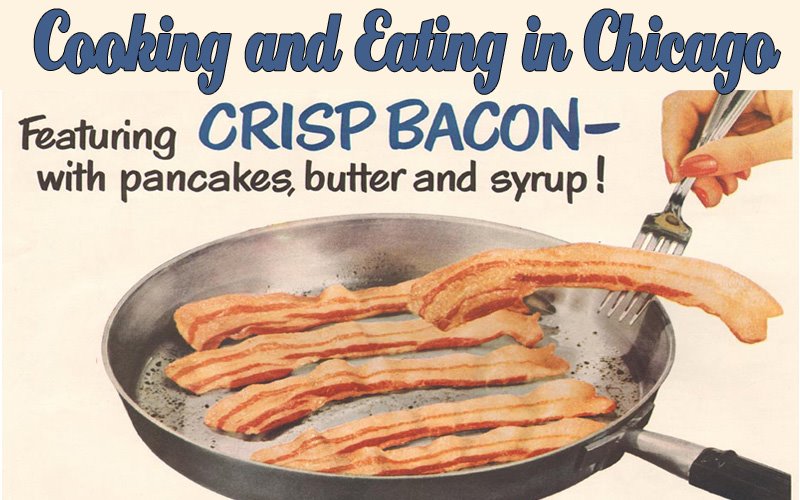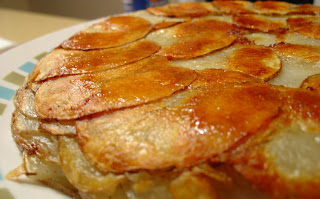
So I finally made the 15 minute drive over to
Burt's Place to try the
much-talked about pizza.
This place is quite the experience. It's been written up in
Saveur and
TimeOut Chicago, but both of those articles are really more about the pizza, and Burt's personal landmark status in the Chicago pan pizza universe (he founded Inferno in Evanston, Gulliver's in Rogers Park, and Pequods in Morton Grove). These pieces don't go into much detail, however, about the overall experience, so I'm glad I read the thread (linked above) on LTH Forum and was prepared for all the "quirks" of this place.
Some have commented that Burt's is the pizza equivalent to Seinfeld's "soup nazi". I'm not sure I'd go that far, but it might be fair to compare Burt's recommended protocols to those of
Kenny Shopsin. The main thing is that you need to call and order your pizza ahead of time. Which, if you know about it, isn't really anything all that difficult. But Burt can complicate things--he's known to take the phone off the hook when things get hectic, there's no website to consult before ordering, and during busier times, he'll invoke the "nothing but pizza" rule.
This kind of thing can be off-putting to those who are caught off guard, especially in our current "customer is always right" universe, but I've been reading about this place for years so I thoroughly briefed the longtime friend I went with and ordered our large sausage, mushroom, and fresh garlic pizza well ahead of time.
I ordered our pizza to be ready at 7pm and, when I walked through the door at the stroke of seven, the small dining room--which resembles kind of a run-down northwoods lodge (or maybe your crazy old uncle's basement decorated in the 60's to look like a run-down northwoods lodge)--was nearly empty. "What's the big deal," I wondered, "guess I didn't need to order ahead of time after all." There weren't any employees in sight and I wondered if I should go ahead and seat myself while I waited for my friend to arrive.
But, like a flash, the host/waiter/busboy (fellow LTH'er Buddy Roadhouse) greeted me, asked me if I'd ordered ahead (gave a look of relief when I said 'yes'), and asked if I was eating in or taking it to go. When I said we were eating in, he recognized my order and name, and quickly guided me to a pre-set corner booth all set up with water and menus.
I called my friend to see where he was, and he was just turning down Ferris, so he would just need to park the car. Buddy emerged and asked if we were ready for the pizza. (They do not play around at this place. If you order your pizza for seven, it's ready precisely at seven.) I indicated that my friend was just parking the car, so, sure, go ahead and bring it out. My friend arrived, we ordered a pitcher of beer, and the pizza was served up promptly and courteously.
As we were eating, the place filled up some (but not totally--they use the large center table as kind of a serving area, where Buddy keeps the pizza pans, water pitchers, and such) and we watched as group after group coming through the front door were told either that they'd have to wait one and a half to two hours, or that it wasn't possible for them to get pizza tonight at all.
My friend was simultaneously incredulous and thrilled by this. He couldn't believe it. "What kind of place is this? Who does that?", he asked. "I tried to tell you," I replied. But we both enjoyed the feeling of being 'in the know' and eating this pizza that was apparently so in demand that others were not able to purchase it--at any price.
We chatted a bit with Buddy about the whole calling in ahead thing and he came across as pretty defensive, which, if you read the thread on LTH, is pretty understandable. Much has been made of this policy and there are about as many critics and annoyed would-be customers as there are fans. "We heard about the rules, so we knew to call in the order," I said.
"They're not rules," Buddy replied, a bit of exasperation becoming evident, "we're just trying to make sure that you have the best experience possible. There's just only so much pizza we can make--Burt only makes so much dough every night, the kitchen is tiny. So this is the only way we can make sure that the customers are happy. We're doing this for you!"
I didn't press it with him. It seemed a touchy subject and I was just happy to be eating the fine pizza and drinking cold beer that came complete with frosted glasses.
Don't get me wrong. Buddy wasn't gruff or inhospitable. Not at all. In fact, I found him to be extremely welcoming and pleasant. His service came with a bit of a flourish, in fact; the kind that often comes at fine dining establishments, only his was done in kind of a tongue-in-cheek way that I found simultaneously charming, funny, and real. This guy has worked for Burt at various places for some thirty years, and it's clear that he understands the pitfalls that lay between (increasingly entitled and demanding) customers and Burt's stringent pan pizza wizardry.
Ok....so how was the pizza?
Very good. Excellent, even. My expectations were very high. I was expecting to pronounce this the best pan pizza in the Chicago area, and I've been eating the landmark pizzas at Malnati's, Gino's East, and Uno/Due for my entire life.
Burt's is a similar, but different pizza than those. It's noticeably lighter and easier to eat than those aforementioned gut-bombs. I'm a big eater, but I have trouble eating more than two large slices from the epic Chicago pizza institutions. At Burt's, though , I was easily able to eat half a large pizza (four slices) and would've had more, if my friend and I hadn't polished off the whole thing.
The standout elements, for me, at least in this initial visit, were the sauce and the sausage. I'm not one that usually even notices the sauce on a pizza, but this sauce was truly excellent. Very sweet, with great fresh tomato flavor, and a vivid bright red color. It was less pasty than most pizza sauces as well, resulting in a more well-lubricated finished product.
The sausage, also, stood out, more for what it wasn't than for what it was. It was a truly tasty, high-quality sausage with lots of great garlic and fennel flavor, but what struck me about it was the restraint in its application. It was applied with a light hand. The standard-bearers of Chicago pan use what I call the "manhole cover" method of sausage application. By that, I mean that the entire pizza is completely covered with sausage. This is sometimes referred to as "the sausage patty". It's good, but I only really enjoy it for about five bites, then it becomes overwhelming, heavy and leaden. By the end of your second slice, you're thinking "ugh...get this pizza away from me". In my family, a work-around we've come up with for this is to order one sausage and one only cheese (or cheese and veggies) pizza, and then kind of alternate eating them, to achieve a better balance.
Burt's solves this problem by giving large (2-3 bites) chunks of sausage, but spacing them out pretty well so that they don't overwhelm. I found it to be the perfect amount of sausage. Less is sometimes more.
Now. I'm a crust guy. I'm usually not all about the toppings. Honestly, unless they're offensively bad or stand-out good, I don't really notice them all that much. I go back to places for their particular style of crust.
Burt's reputation focuses on the crust, which is why my expectations were so high. Burt is known for pioneering the "caramelized cheese" crust technique, where a liberal amount of cheese is applied under the pizza, along the outer rim of the pan, resulting in a crunchy burnt cheese layer that kind of bonds with the crust.
On this front, I was disappointed. Our pizza was almost devoid of the burnt cheese endcap, and the dough was just ok. It was fluffier and lighter than the usual pan pizza crust, and had a much more bread-like feel to it, almost like a focaccia dough. I was expecting something much closer to the flatter, crunchier 'short-dough' consistency found on most pan pizza. Also, the crust on our pizza wasn't particularly crunchy. It wasn't soggy or anything, but I like a good strong crunch and crispness to my pizza.
But, I'm willing to go back and try again. I have read that the larger sizes (we ordered a 14") don't get as crunchy so they should be ordered well done. I'll probably just order two smaller pizzas next time, as that will give us more of an opportunity to try the great toppings. And, as with any craft-produced product, each one is a bit different, the maker sometimes has an off night, ovens run funny sometimes, etc, etc. The toppings were so exceptional that I will gladly make a bit of an effort to figure out how to get the crust the way I like it.
Leeway extended.
As far as some of the more extraneous details, I feel compelled to address the overall look and feel of the place. Some have commented that the place is "dirty" and my famously finicky mom, who my dad dragged there a few months ago, has, with a wrinkle of her nose, pronounced Burt's to be "filthy". When pressed about what, specifically, is so dirty, she cites dust on the antique radios and assorted tschochkes scattered around the room. Hmmm.... As far as I'm concerned, since I'm not eating off the dusty old radios, who cares? How's the pizza?
But to address these points, I didn't find it to appear dirty, but Burt's dining room does have an older, "well worn" feel to it. It's homey. The decor looks to be based around mid-century Stuff Burt Likes. There's an ancient stereo over in one corner occupying space where a table could be, and it's playing old jazz or classical music. The lighting is very dim (and, honestly, the radios are all kept way up on high shelves, so I have no idea how my mom could've even seen if they were dusty) and there's a kind of feeling that this is a restaurant that time forgot. It feels like it's been there forever.
I can see how people might interpret that as "dirty" or whatever, especially given the current corporate standardized restaurant decor model that we all have become so familiar with, but all that's required is a bit of a paradigm shift to overcome this. Think of it not as a restaurant, but as an extension of Burt and (his wife) Sharon's home. Hence the name.
Burt is 71 years old and has pledged to keep making pizzas until he's dead. He's been doing this forever and has done it in larger and more profit-minded restaurants, and now he's doing it in a tiny little place on a strangely deserted-feeling little side street off Dempster in Morton Grove. I get the feeling that he's not doing it for the money, the reputation, or the word of mouth. I think he's doing it because he likes making great pizza. So he's doing it his way. My sense is that he's of the mind that if you don't like how he does it, he'd be happy to have you go to Malnatis, Giordano's, or wherever, and would direct you there without hesitation.
I happen to like how Burt does it, and am kicking myself for not having tried this little gem of a place years ago. It's close to where I live so I feel lucky to be able to avail myself of Burt's pan pizza for takeout orders on the nights that we don't feel like enjoying the quirky yet welcoming service in their small homey dining room.
Especially since I now understand "the rules".


























